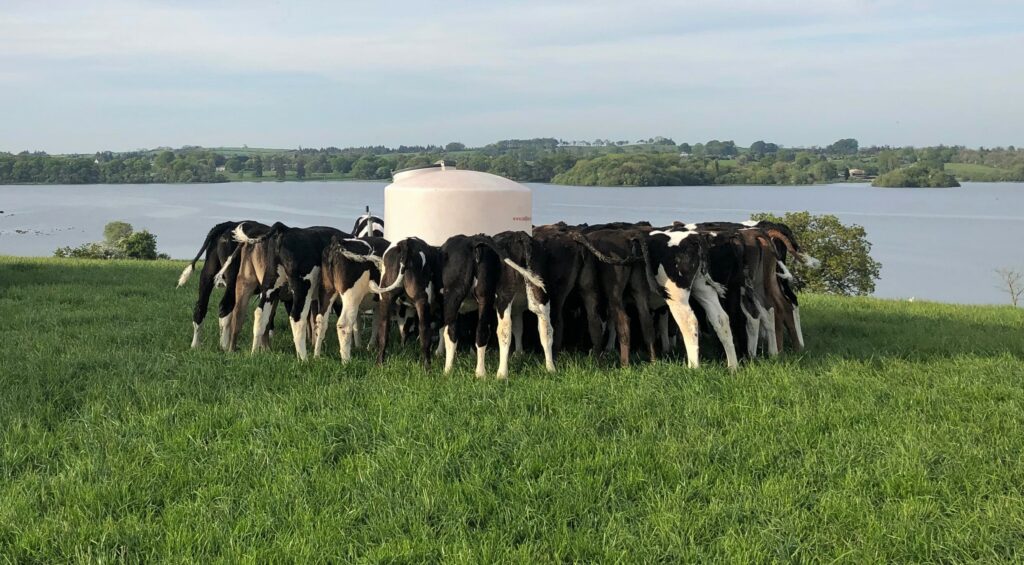The chaos that comes with calving a large number of cows in a short space of time is fast approaching on many spring-calving dairy farms.
However, AgriLand has compiled a list of different ways farmers can relieve some of the pressure at this busy time of the year.
1. Minimise the chances of a disease outbreak
In the midst of the calving season the last thing anyone wants is a disease outbreak.
To avoid this, ensure that your cows are up to date with all vaccines. Where scour – in particular rotavirus – is an issue, a one-shot vaccine can be administered between three and 12 weeks before calving to prevent this.
Also, make sure the calving area, calf housing and feeding equipment are thoroughly cleaned and disinfected before use. In addition, feeding sufficient dry-cow minerals in the lead up to calving will help avoid any metabolic diseases.
Last but not least, feeding adequate colostrum to calves is key to their survival. At least 3L of colostrum per calf should be fed as soon as possible after birth.
2. OAD feeding and/or milking
According to Teagasc, no differences in calf performance or health were observed between calves fed once-a-day (OAD) or twice-a-day (TAD) in trials carried out in Teagasc Moorepark.
However, there was less time spent with calves fed OAD and a 36% overall saving in total calf care time was achieved.
Similarly, to reduce the workload in February, some farmers may opt to milk OAD for the first few weeks during the calving period.
OAD milking has been shown to reduce the labour requirement, while only having a minimal impact on annual milk production.
3. Get cows out to grass early
Trying to get cows out to grass early is another easy way of reducing the workload in the spring.
The downtime between now and when calving is due to start should give you enough time to get set up for the next grazing season.
Make sure all reels are working correctly and all posts are gathered up ready to go for grazing this spring.
Think about where you are likely to graze first; think about which paddocks will have the heaviest covers; and think about those which may be difficult to graze.
Then answer the following questions:
- Could any improvements be made in terms of my grazing infrastructure?
- Would another gap/entrance be beneficial?
- Would installing a spur roadway help?
- Are all my roadways up to scratch?
- Could another drinker or moving an existing drinker help with grazing next spring?
4. Use different technologies and innovations
There are many technologies and innovations out there to help reduce the workload in the spring.
Also Read: Could this innovative gate work for you next spring?These could include: an automatic calf feeder; a calving camera; a milk trolley; a milk heater; a mobile milk feeder; and a calf transporter/cart to name a few.
5. Have SOPs in place
A standard operating procedures (SOP) is a document or a sign with a clear step-by-step guide or instructions on how to complete a particular task or procedure on the farm.
All SOPs don’t necessarily have to be written down, once they are clearly communicated to all farm employees.
SOPs can be adopted for tasks such as the milking routine, washing the milking machine, calf feeding, treating a cow for mastitis, treating a calf with scour and many more tasks that farmers perform on a daily basis.
Having SOPs in place reduces the amount of time spent explaining how to do specific task(s) to employees as well as providing direction and improving communication and consistency. They are also useful in the case of an emergency.
6. Rear calves outdoors
Given the expansion that has occurred on many dairy farms, some farmers may find that they are short of space next spring.
A simple solution to this may be to turn calves out earlier than normal. Although this depends on weather at turn-out – as calves should be turned-out when a few dry days are forecast.
Research by Teagasc has determined that calves turned out at four-to-five weeks old – with suitable shelters available – could be reared without compromising weight gain and vitality, compared to calves reared indoors during the milk feeding period.
Outdoor rearing tips:
- Select a dry, sheltered paddock near the farmyard;
- Provide a temporary shelter. Ideally, this should be portable;
- Have a suitable method of feeding calves and transporting feed to the paddock;
- Provide a trough for concentrate and fresh water at all times;
- Try not to use the same field each year to minimise parasite build up;
- Offer fresh grass daily once intakes improve;
- Make sure only healthy calves are turned out.





